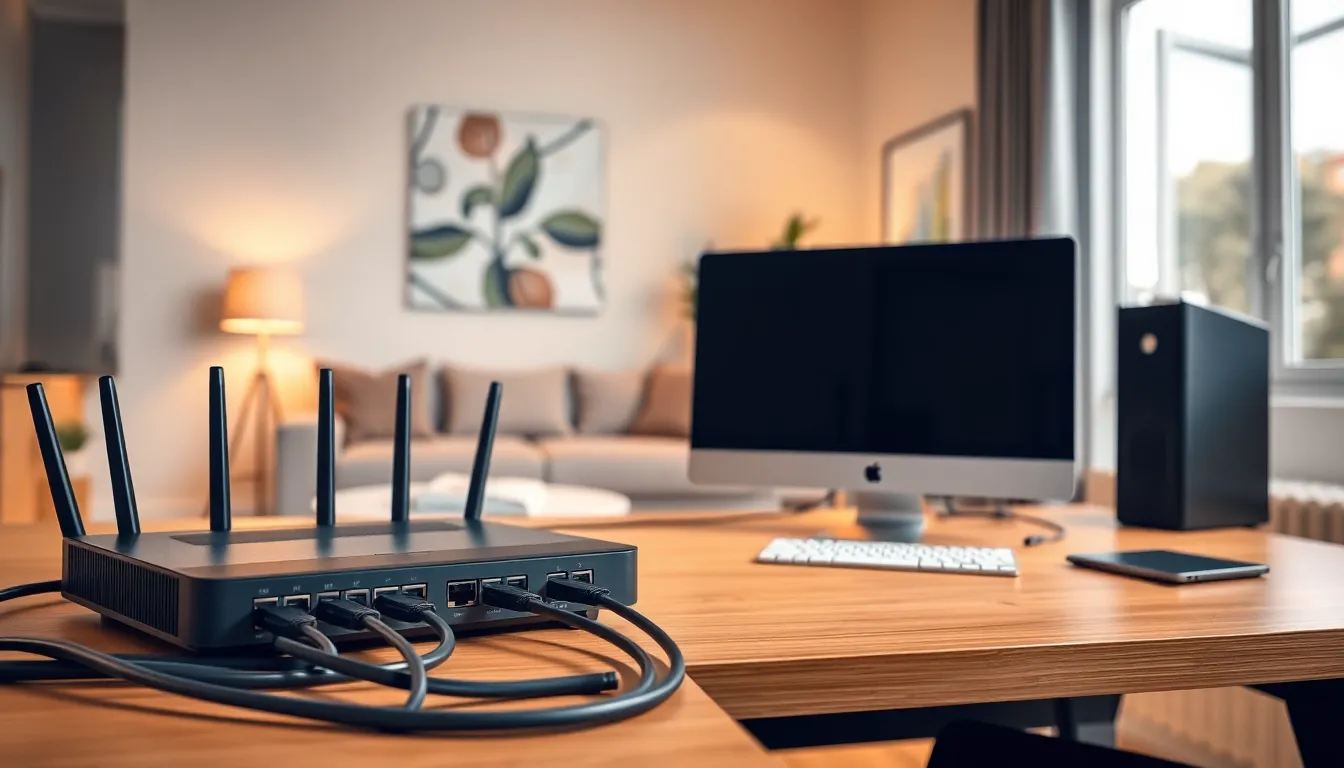In today’s digital age, a strong home network isn’t just a luxury; it’s a necessity. Imagine trying to stream your favorite show while the Wi-Fi signal plays hide-and-seek. Frustrating, right? With more devices connecting to the internet than ever before, understanding how to set up and maintain a reliable home network can feel like solving a Rubik’s Cube blindfolded.
Fear not! This home networking guide is here to turn you into a tech-savvy wizard. Whether you’re a casual internet surfer or a hardcore gamer, mastering your home network can help you avoid those awkward buffering moments. Get ready to dive into the world of routers, extenders, and bandwidth—where the only thing more powerful than your connection will be your newfound knowledge.
Table of Contents
ToggleUnderstanding Home Networking
Home networking connects various devices within a household, allowing seamless communication and internet access. A strong home network supports multiple users and devices while providing fast, reliable connections.
What Is Home Networking?
Home networking refers to linking devices such as computers, smartphones, tablets, and smart home appliances. It creates a local area network using routers, switches, and access points. This network allows users to share resources, such as printers or files, while accessing the internet simultaneously. Establishing a well-structured home network ensures that devices communicate effectively and efficiently.
Importance of Home Networking
A strong home network enhances internet reliability and speeds up online activities. Users benefit from uninterrupted streaming, gaming, and video calls when connections are stable. Aside from convenience, efficient home networking improves device performance and security. It protects personal data from unauthorized access while ensuring all devices remain functional. Understanding the importance of home networking helps users make informed decisions about equipment and setup.
Types of Home Networks

Home networks typically fall into two categories: wired networks and wireless networks. Each type provides distinct advantages and limitations, ensuring that users can choose the best fit for their households.
Wired Networks
Wired networks use Ethernet cables to connect devices physically. These networks offer stable connections and high speeds, making them ideal for activities that require consistent bandwidth, such as online gaming or video streaming. Installation involves running cables from a router to each connected device, ensuring reliability. Home offices often benefit from wired connections, as they minimize interference from outside sources. With proper setup, wired networks deliver lower latency compared to wireless options.
Wireless Networks
Wireless networks employ radio waves to connect devices without physical cables. These networks facilitate mobility, enabling users to access the internet from various locations within their homes. Though convenience is a significant benefit, wireless networks can experience interference from walls, other electronics, or neighboring networks, impacting performance. With advancements in technology, modern routers provide extended range and faster speeds. Users can enhance their wireless experience by strategically placing routers and utilizing range extenders to cover larger areas.
Essential Home Networking Equipment
A reliable home network relies on specific essential equipment. Understanding these components helps enhance overall connectivity and performance.
Routers
Routers serve as the central hub for a home network. They manage data traffic between all connected devices and the internet. Modern routers support dual-band or tri-band frequencies, allowing simultaneous connections without interference. Users should prioritize routers with features like Quality of Service (QoS) to prioritize bandwidth allocation for specific devices or applications. Additionally, security protocols such as WPA3 provide enhanced protection against unauthorized access.
Switches
Switches expand the network by connecting multiple devices through wired connections. They function efficiently by enabling signal transmission without significant data loss. Managed switches allow users to monitor and control network traffic, offering increased performance and security. For homes with several wired devices, having at least one switch can greatly improve stability. Models should come with sufficient Ethernet ports to accommodate all devices, facilitating fast and reliable communication.
Access Points
Access points extend the home network’s wireless coverage. They connect to the main router, enhancing signal reach in larger homes or areas with obstructed signals. Users often place access points strategically to eliminate dead zones and boost connectivity. Dual-band access points support various devices, providing better performance for specific applications. It’s essential to choose access points that support the latest Wi-Fi standards for optimal speed and reliability.
Setting Up Your Home Network
Setting up a home network requires careful consideration of layout and device connections. Following these steps enhances overall performance and connectivity.
Planning Your Network Layout
Start by identifying the main usage areas in your home. Create a central location for the router to maximize coverage. Consider placing the router at an elevated position, like a shelf, to reduce obstructions. Determine which areas require wired connections and which can operate wirelessly. Use a diagram to visualize device placement, ensuring optimal signal strength across all rooms. Account for potential interference from walls, furniture, and appliances. Prioritize high-bandwidth activities, such as streaming and gaming, to inform your layout decisions.
Connecting Devices
Begin connecting devices after establishing the layout. Plug the router into a power source and connect it to the modem using an Ethernet cable. Use additional Ethernet cables to link any stationary devices, like desktop computers or gaming consoles, to the router. For wireless devices, such as smartphones or tablets, access the Wi-Fi settings and connect to the network by entering the password. Secure each device by updating firmware and software regularly. Ensure to monitor connections for stability and speed, adjusting settings as necessary for optimal performance.
Troubleshooting Common Issues
Common home networking issues can disrupt internet experience. Identifying and resolving these problems ensures a smoother online activity.
Slow Internet Speeds
Slow internet speeds often stem from various causes. Bandwidth overload occurs when multiple devices stream or download simultaneously. Connectivity to the router can affect speed; positioning the router in a central, elevated location helps. Checking for firmware updates ensures optimized router performance, enhancing overall speed. Users might also find it beneficial to limit bandwidth-heavy applications during peak hours. Additionally, running speed tests can identify specific devices causing the slowdown.
Connectivity Problems
Connectivity problems are frequent and can frustrate users. Weak signals may arise from physical obstructions like walls or furniture. Maintaining a clear line of sight between the router and devices enhances performance. Network interference from devices like microwaves or cordless phones also disrupts connectivity. Restarting the router can resolve minor glitches quickly. Using Ethernet cables for stationary devices ensures a stable connection. Lastly, checking for unauthorized devices on the network can help maintain speed and security.
A reliable home network is essential for navigating today’s digital landscape. By understanding the key components and strategies outlined in the guide, individuals can create a robust network that meets their needs.
Whether opting for a wired or wireless setup, it’s crucial to prioritize equipment that enhances performance and security. Regular maintenance and troubleshooting will further ensure a seamless internet experience.
With the right knowledge and tools, anyone can transform their home network into a powerful asset, enabling smooth connectivity for all devices and protecting personal data from potential threats.








